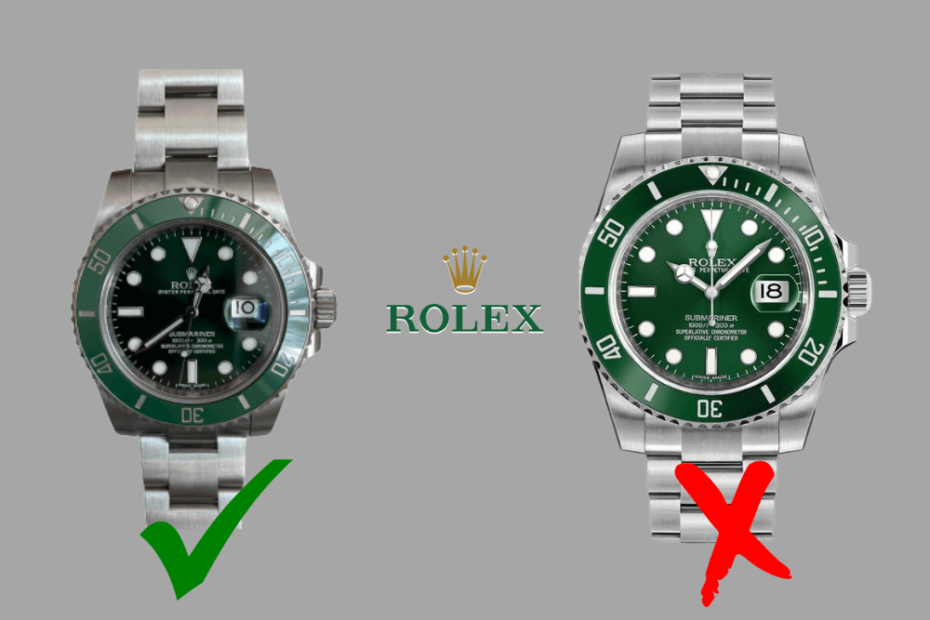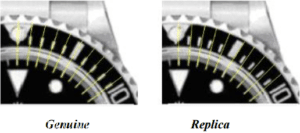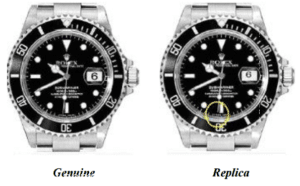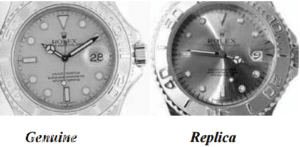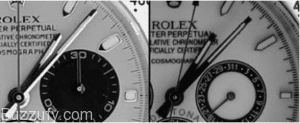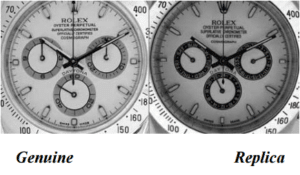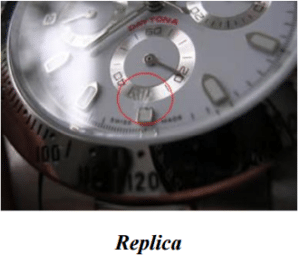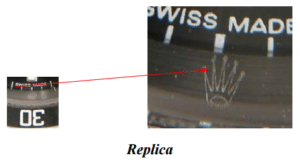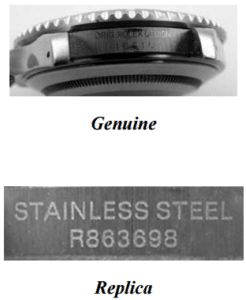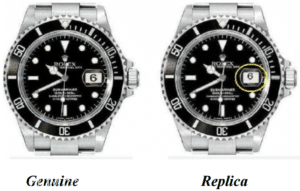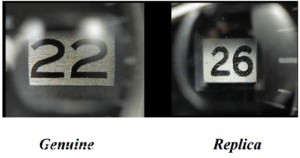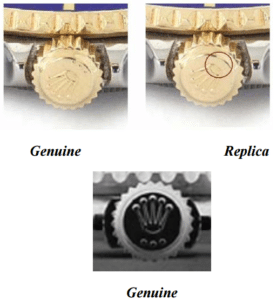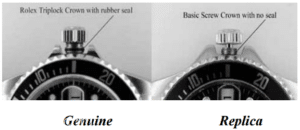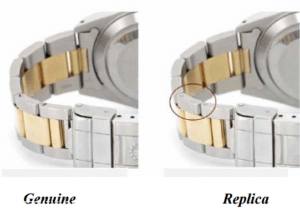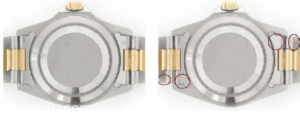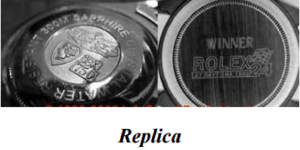How to identify fake Rolex?
The Origin
A Swiss based company would not sell a watch that is made in Indonesia, so if you notice that the watch’s origin doesn’t match the origin of the company, then the chances are the watch is a fake.
The Band
The edge on a genuine watch will have a smooth edge; this is because the band was made out of three pieces of metal. One rolled piece with two outer edges. With most cheap watches each link is made of a single piece of metal, which is rolled to create the link. This is easy spotted as the edge of each link is rolled like a “Swiss Role” and has a poor quality finish.
The Bezel
The Bezel if moved should line up exactly with the minute markers on the dial. On a genuine both markers will line up perfect.
The Second Hand
All Rolex watches will have a sweeping second hand. If the second hand “tick tocks” then it is definitely a copy. The Rolex second hand should reach the second markers, if it is short by 2-3mm then it is a replica, the illuminated circle on the second hand should hit the top of the 12 o’clock triangle exactly. On most replica watches when the stem is pulled out, the second hand continues to move. On a genuine watch the second hand should stop once the stem is pulled out.
Minute Hand
Genuine Rolex Yacht-Master models feature a “minute” hand, which is considerably thicker than those on other Rolex sports models. However, to save money, counterfeiters will often use the same hands found on the Submariner. This can be easily identified when viewed side-by-side (as shown in the example below).
Daytona Hands
Counterfeiters will often use hands which are of the wrong size and/or shape. In the example shown below, the genuine Daytona features a “minute” hand which reaches all the way to the outer “hash” marks. However, the counterfeit model shown features much shorter hands. This is often the case because counterfeiters use whatever stock of parts they have available, which is usually whatever is the cheapest.
You will also note that the “shape” of the hands on the counterfeit is incorrect. modern Daytona models feature hands which are “rounded” on the tips. Again, counterfeiters will often use whatever hands they have available, and in this case they have used hands from a Day-Date model, which are flat on the tip.
Daytona Registers Genuine
Rolex Daytona models feature mini-registers on the dial which perform Chronograph “stop watch” functions (i.e. elapsed hours and minutes). It is also worth mentioning that the large “sweep” hand on the dial is also part of the stop watch function, and is not the primary second hand– the second hand for the watch is the small 20/40/60 register.
However, counterfeit models will rarely perform these functions, but rather will be used for “day of week”, “date”, and “24-hour time”. (Please Note: not all counterfeit models will be “printed” with these incorrect functions, but their operations will still be incorrect.)
Furthermore, the size and position of these mini registers will often be incorrect on counterfeits. As shown in the example below, the counterfeit model features much smaller registers which are positioned too far inward on the dial, while the genuine Daytona features registers which are positioned much farther outward–almost touching the 3-6-9 hour markers.
The Crystal Glass/ Micro Etched Crystal
Brand new for 2002, Rolex has started micro-etching a tiny “coronet” (or crown) logo into the crystal, at the 6 o’clock position. This mark is quite small, so it is difficult to see with the naked eye. However, when viewed under a loupe, the faint outline can be distinguished, as seen in the examples below.
Please Note: Rolex has just started phasing-in this micro-etching process and, to date, not all models have the etching. It is believed that the etching should appear on most (if not all) new models produced by the end of 2003, or early 2004.
You will notice that the fake etching is “similar” to that in the genuine example, the biggest difference being that the “balls” on the tips of the fake are too small. The etching also is not precise.
Case Reference Number
Probably the most accurate way to identify a genuine/counterfeit Rolex watch is by locating the Serial and Case Reference Numbers. These special identification numbers are engraved on the side of the case, located between the lugs (as shown in the below example). These reference numbers should match with the paperwork supplied with the watch.
As you can see in the examples below, the engraving between the lugs of a genuine Rolex feature very fine lines, which actually catch the light similar to that of a diamond cut edge. However, (some) counterfeits will feature a sandy (acid) etched appearance, as seen in the example below. Furthermore, the spacing on these numbers is often too close together. It is worth mentioning that counterfeiters frequently use the SAME numbers on their watches. Thus, the example shown above: “R863698” is seen quite often, and is a pretty good sign of a fake.
A Brief Explanation of the Rolex Serial Numbering System
In 1927, Rolex began issuing every Rolex Oyster case a unique serial number to distinguish them from one another. Around 1953, the numbers reached the 999,999 mark, at which time Rolex decided against adding a 7th digit, thus continuing into the “millions”–Instead, they started the sequence aver at 100,001.
Around this ame time, Rolex had initiated another dating system–They stamped the inside of the case back with a code consisting of a Roman numeral and two numbers. The Roman numerals were I, II, III, IV, which represented which quarter of the year the watch was produced. The numbers simply represented the two-digit year in which the watch was produced. Therefore, the code III 53 would represent the 3rd quarter (i.e. July-September) of 1953–this code continued until around 1970.
In the early 1960s, Rolex once again reached the 999,999 mark, but this time added a 7th digit and continued until mid 1987, when the numbering reached 9,999,999. At this time, Rolex elected to start numbering with a letter prefix (e.g. R000001). The system started with the letter “R”, which was then subsequently followed by L-E-X. Thus spelling out the word “ROLEX” with the “O” being omitted, to help avert any possible confusion with the number “0”. This sequence continued through November 1991, when a new numbering system was introduced utilizing the letters N, C and S, which took them through 1993. In 1994, Rolex started yet another sequence with the letters: W, T and U, then A, P, and K in subsequent years.
To add to the confusion, many of these prefixes have run concurrently over the past few years, giving the appearance of a random numbering system. Therefore, only Rolex knows exactly when any particular watch was made and they aren’t talking. The following list is comprised of known serial numbers for the years listed. By checking a particular serial number against this list you should be able to date a watch with reasonable accuracy. However, it is no guarantee as to when your watch was shipped from the factory.
The Font.
The fonts used for the numbers should align exactly with the second hand as it passes over them. The numbers in the date bubble should be exactly in the centre of the magnified Cyclops. On virtually all replicas the date will either be high or low in the date window.
The Date Bubble/Cyclops
The Cyclops on a genuine Rolex watch will be magnified by 2.5. A replica will have either no magnification or a very small amount of magnification. On a genuine the date should practically fill up the Cyclops. The Cyclops will also have a sharp edge where the Cyclops meets the crystal. This is hard to see with the naked eye but can be felt quite easily by running your fingers around the Cyclops.
The Crown/Winder
The crown on an expensive watch such as a Rolex will be made out of a single piece of metal. On a fake watch the logo that is placed on the crown is glued on after the watch is made. The small glued seem can be seen when using an eyeglass. The crown will also have three small dots or a line as shown in the picture.
Rolex models featuring the Triplock crown (i.e. Submariner, Sea-Dweller and Daytona) utilize an extra seal within the threads of the winding crown’s tube. This gasket resembles a black o-ring and can be visible when the winding crown is unscrewed fully. As shown in the example above, (most) counterfeit models will not feature this o-ring seal, but rather will have basic screw-down threads. It is worth mentioning that some new counterfeits will feature a “similar” looking rubber seal, but upon closer examination you will see that it is merely cosmetic, and is not functional.
The Pins
The pins holding the strap to the watch on a genuine will be threaded. If you look through an eyeglass at the end of the pin you should see a small slot for a fine flat head screwdriver.
The Case Back
An authentic Rolex will have a screw down back with exactly 144 small teeth. You can only open a Rolex case with a special Rolex tool.
Reference Numbers will be etched in the positions as indicated above by a red circle. If you see no reference numbers then the watch is a fake. To date Rolex have never made a watch with a clear or see through back. This is also known as a skeleton back which allows you to view the movement. These clear back watches are a common Rolex fake.
Rolex watches do not have engraved backs. Genuine Rolex watches will have either a smooth case back or a smooth case back with a hologram showing a reference number.
For maximum safety, contact a specialist or representation of Rolex!
